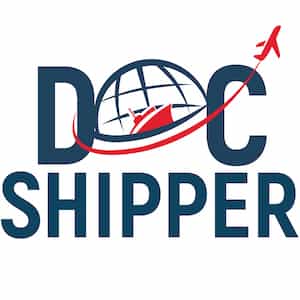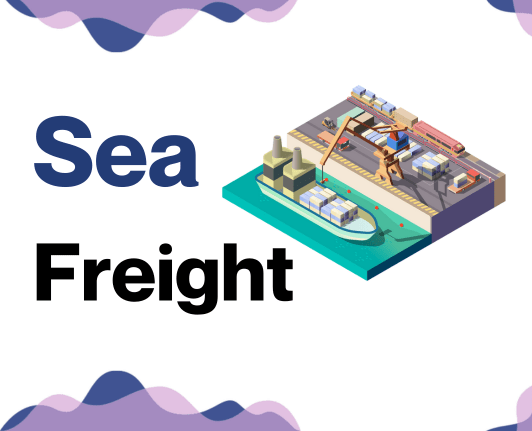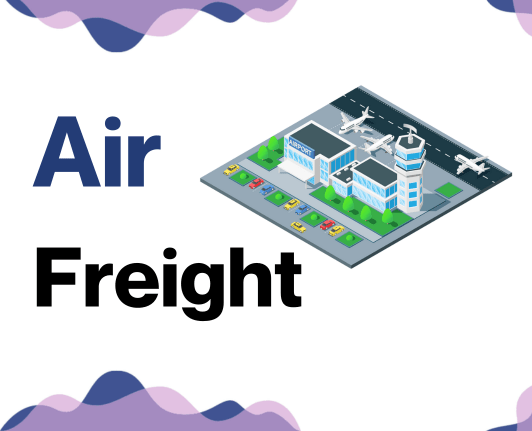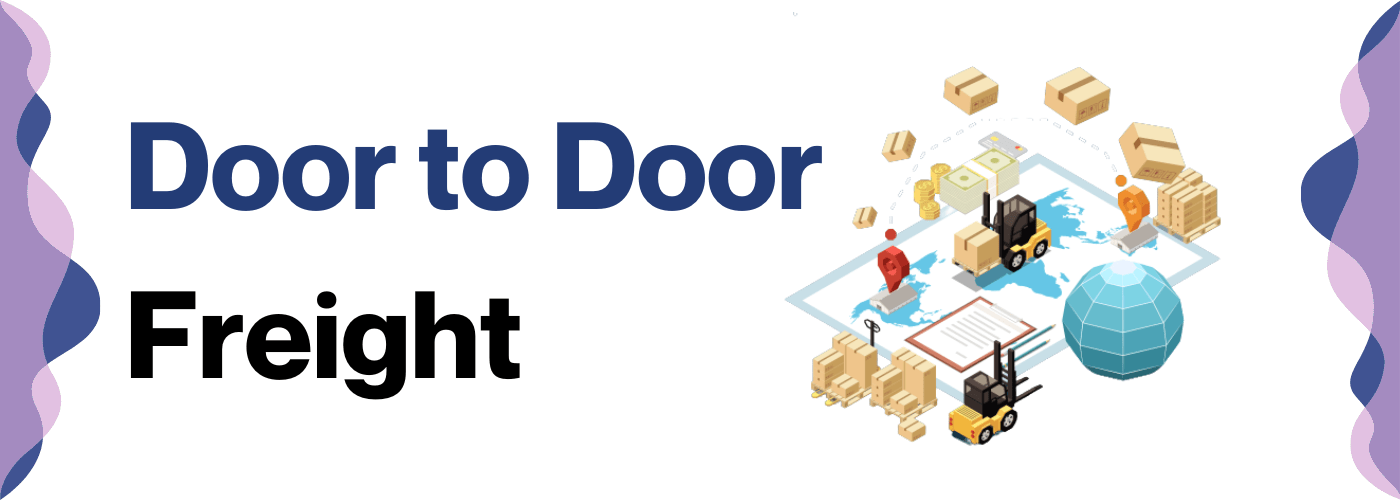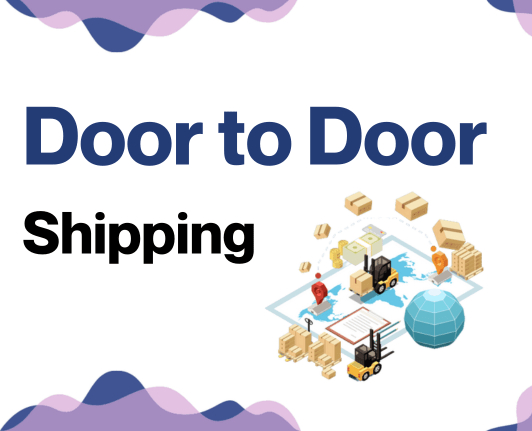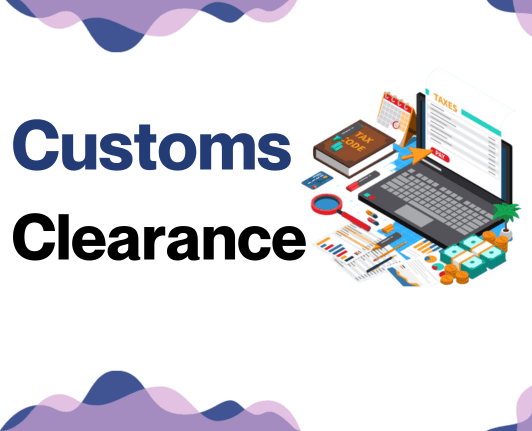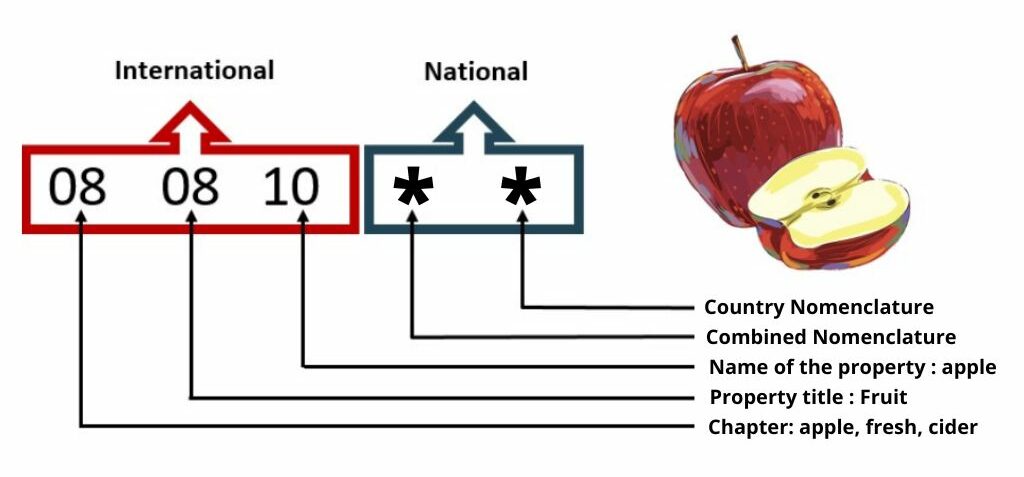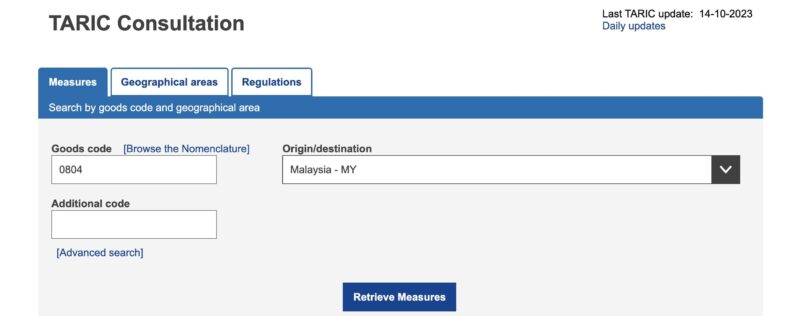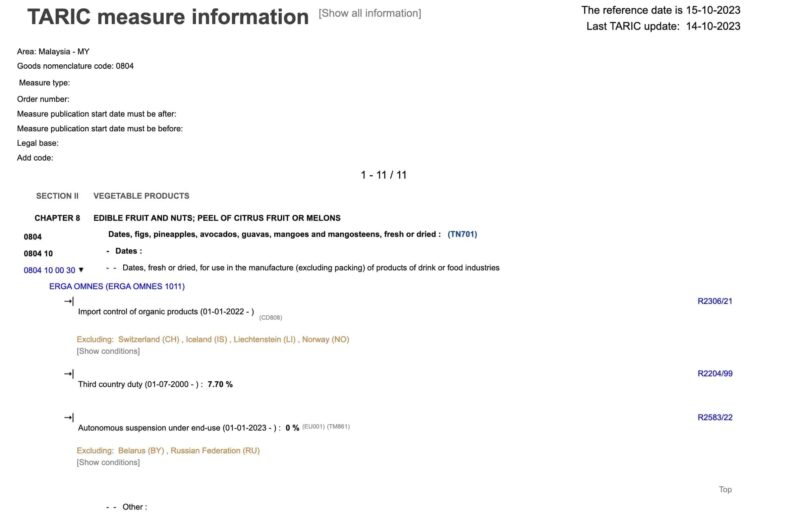Ever tried to conduct a symphony of shipping goods from Malaysia to Europe? It's a more complicated melody than you'd think. Understanding freight rates, demystifying transit times, and getting to grips with customs regulations are notes that often sound discordant to businesses.
But worry not! This guide, tailored to the specific needs of businesses, unravels the complex web of freight transport between Malaysia and Europe. We will explore the different types of freight options, provide insight into the customs clearance process, and reveal the true story behind duties and taxes.
If the process still feels overwhelming, let DocShipper handle it for you! As an international freight forwarder, we are your capable maestro seamlessly orchestrating all moving parts of your shipping process – changing your challenges into a harmonious symphony of success.
Table of Contents
Which are the different modes of transportation between Malaysia and Europe?
Choosing transportation from vibrant Malaysia to vast Europe isn't simply 'this or that'. Picture a menu, where each choice serves different needs. Consider the distance, it's like journeying from a flicker of fireflies in a Kuala Lumpur night, to the twinkling Eiffel Tower lights. Air freight is your quickest choice, a 'bullet train' transporting your goods. Yet, the 'old reliable' is sea freight, affordable with more carry weight, like a 'strong elephant'. However, it’s a longer journey, a stroll compared to a sprint. Your choice depends on your shipment's nature, almost like choosing the right gear for a mountain trek.
How can DocShipper help?
Shipping between Malaysia and Europe can be tricky - but not with DocShipper. We handle the ins and outs of your shipment, ensuring swift customs clearance and smooth sailing all the way. Have a question or need a quote? Free consultations and estimates within 24 hours are just a dial away with our expert team. Reach out now!
DocShipper Tip: Sea freight might be the best solution for you if:
- You're dealing with hefty quantities or oversized goods. Sea transport is your go-to for maximizing space without stretching your budget.
- Time sensitivity isn't a concern for your shipment. Ocean freight is known for its leisurely pace, especially when compared to the speed of air or rail.
- Your supply chain connects key international harbors. This positions you to take full advantage of a wide-reaching network of ocean trade routes.
Sea freight between Malaysia and Europe
Undeniably, shipping between Malaysia and Europe is an extensive supply chain that many businesses utilize, with major cargo ports like Port Klang in Malaysia and Rotterdam in Europe serving as pivotal industrial hubs. Connecting these two points, ocean shipping emerges as a vital link. It may not win any races in terms of speed, but it takes the crown for being a cost-effective way of moving large volumes of goods across continents.
Yet, it's not just a simple sea voyage from A to B. Shippers often face a turbulent storm of challenges - like a captain navigating tough waters - especially when it comes to the intricate aspects of customs, duties, and legalities. It's like packing for a vacation without knowing the weather or dress code of your destination; the result is often a suitcase full of unsuitable items. To ease this journey, we'll voyage through the best practices, key specifications, and pro tips that can transform you from a lost sailor into a seasoned maritime navigator.
Main shipping ports in Malaysia
Port Klang
Location and Volume: Port Klang, situated in Selangor, Malaysia is the nation's busiest port. It has a shipping volume of over 13.7 million TEUs making it the 15th busiest port in the world.
Key Trading Partners and Strategic Importance: Major trading partners include China, Singapore, United States, and Japan. As the main gateway by sea into Malaysia, it holds the strategic location on the Strait of Malacca.
Context for Businesses: For businesses aiming to serve the robust Southeast Asian markets, leveraging Port Klang can provide access to efficient transshipment services and extensive connectivity to major global shipping routes.
Tanjung Pelepas
Location and Volume: Tanjung Pelepas, located in Johor, is not just Malaysia's second-largest port but also ranks 12th worldwide. It boasts a shipping volume of about 12.5 million TEUs.
Key Trading Partners and Strategic Importance: Its key trading partners include China, Singapore, and Europe. The port is strategically located at the confluence of the main east-west shipping lanes, offering an advantage to shipping lines that have East Asia -Europe services.
Context for Businesses: If your business is looking to streamline container shipping processes while saving on costs, Tanjung Pelepas with its modern facilities and strategic location might be an ideal choice.
Port of Penang
Location and Volume: Nestled in the Northwest region of Peninsular Malaysia, the Port of Penang services a significant amount of shipping volume of about 537.426 million TEUs.
Key Trading Partners and Strategic Importance: Its main trading partners are China, Singapore, USA, Japan, and Thailand. The port plays a strategic role in cargo movement for the Northern Region of Malaysia.
Context for Businesses: Businesses seeking to penetrate the Northern Malay or Southern Thai markets would find Port of Penang's direct connectivity and efficient handling of cargo beneficial.
Port of Bintulu
Location and Volume: Situated in Sarawak, East Malaysia, the Port of Bintulu is dedicated primarily to the handling of liquefied natural gas (LNG) with an annual capacity of over 50.73 million tons of cargo.
Key Trading Partners and Strategic Importance: Its main trading partners are Japan and South Korea. This port is strategically vital as it's the world's largest LNG production facility on a single site.
Context for Businesses: If you're in the energy sector, such as LNG, Bintulu Port provides an advantageous position in the international LNG shipping routes.
Johor Port
Location and Volume: Positioned in Southeast Malaysia, Johor Port is a multi-purpose port with a shipping volume of about 1.5 million TEUs.
Key Trading Partners and Strategic Importance: Key trading partners include Japan, Singapore, India, Thailand, and China. Johor Port's strategic importance lies in serving as an important maritime, bulk, and general cargo hub.
Context for Businesses: Johor Port should be considered if your business requires frequent maritime, bulk or general cargo transportation throughout Southeast Asia, given its versatile port services.
Kuantan Port
Location and Volume: Kuantan Port in East Peninsular Malaysia serves as a major stopover in the South China Sea, primarily for bulk and dry cargo, with a shipping volume of over 22.9 million freight weight tons.
Key Trading Partners and Strategic Importance: Key trading partners include China, particularly for the export of resources such as iron ore. Its strategic location makes it an essential player in the East Coast Economic Region (ECER).
Context for Businesses: If your business is into bulk or dry cargo, deploying Kuantan Port as part of your shipping strategy could offer impressive cost advantages linked to the shorter shipping times to China.
Main shipping ports in Europe
Port of Rotterdam
Location and Volume: Situated in the Netherlands, the Port of Rotterdam is revered as the largest port in Europe with a shipping volume of 220.7 million TEUs.
Key Trading Partners and Strategic Importance: Its strategic position in Western Europe connects it to key markets in Germany and France. The port has an impeccable accomplishment of being the most technologically advanced European port.
Context for Businesses: If you strive to leverage developments in port technology for more efficient goods handling, the Port of Rotterdam might just be your perfect match, boasting the latest in automation and digitization.
Port of Antwerp
Location and Volume: Located in Belgium, the Port of Antwerp comes second to Rotterdam in Europe. Each year, it attends to around 68.7 million TEUs.
Key Trading Partners and Strategic Importance: With its comprehensive connection to more than 1,000 European inland ports, this port is vital in the smooth trade operations with the United Kingdom, Germany, and Spain.
Context for Businesses: Looking to extend your reach into the European market? The Port of Antwerp’s extensive network makes it an attractive option to access potential customers.
Port of Barcelona
Location and Volume: The Port of Barcelona, located in Spain, houses the third largest port in Europe, handling around 3.5 million TEUs annually.
Key Trading Partners and Strategic Importance: This port plays an integral part in connecting businesses with trading partners in the Mediterranean region.
Context for Businesses: If you aim to effectively tap into the Mediterranean area, then the Port of Barcelona should definitely be in your shipping considerations, given its direct routes to key Mediterranean markets.
Port of Valenciaport
Location and Volume: Located in Spain, the Port of Valenciport handles an annual shipping volume of 343 793 TEUs.
Key Trading Partners and Strategic Importance: Its key trading partners are Italy, the United Kingdom, and China.
Context for Businesses: If you’re looking to extend your business operations to any of these locales, the Port of Valenciaport offers scheduled, reliable services to these partner destinations.
Port of Felixstowe
Location and Volume: The Port of Felixstowe is the United Kingdom's busiest container port, handling 4 million TEUs annually.
Key Trading Partners and Strategic Importance: As the UK's major port, it holds strong connections with European, American, and Asian markets.
Context for Businesses: British businesses aiming to augment their international trade will find the Port of Felixstowe a vital link to foreign markets.
Should I choose FCL or LCL when shipping between Malaysia and Europe?
Making the right choice between Full Container Load (FCL) and Less than Container Load (LCL), more commonly known as consolidation, can make all the difference in your sea freight shipment from Malaysia to Europe. The choice impacts not only your shipping cost and delivery time but also the overall success of your logistical process. As we dive into this topic, we'll equip you with insights to make an informed decision for your unique shipping needs. Let's demystify these options and pave the way for a profitable shipping journey ahead.
LCL: Less than Container Load
Definition: LCL, or Less than Container Load, refers to a mode of shipping where multiple businesses share space in the same container, each paying only for their portion of the space.
When to Use: LCL shipment is an economically viable option when you do not have enough cargo to fill an entire container. For instance, if your freight volume is less than 13-15 CBM (cubic meter), LCL might be the best choice for you.
Example: Let's consider a furniture business based in Malaysia looking to ship a small batch of artisanal chairs to Europe. As the company doesn't manufacture in large quantities, opting for LCL means they only pay for the space they occupy within the container, rather than an entire container.
Cost Implications: The cost implications favour LCL freight when you're shipping less cargo. These costs entail the freight rate per cubic meter, port handling charges, and other fees. Remember, though this method is cost-effective for smaller volumes, the cost may rise with increased volume or weight of your consignment.
FCL: Full Container Load
Definition: FCL or Full Container Load shipping means a single company uses all the space within a 20'ft or 40'ft container. Unlike LCL or Less than Container Load, FCL shipping ensures that the container is used for your cargo exclusively.
When to Use: Typically, FCL is chosen for quantities greater than 13/14/15 CBM, making it most cost-effective for high-volume shipments. The safety element is another key feature. With an FCL container, your freight is sealed from origin to destination, only being opened upon arrival.
Example: Picture a Malaysian furniture manufacturer exporting their products to Europe, for instance. They load a 40’ft container with their inventory, maximizing space utilization. This makes shipment safer, prevents unloading mishaps in transit, and reduces the likelihood of damages or misplaced items.
Cost Implications: When the shipment volume justifies it, FCL becomes more economical as the fcl shipping quote is provided for the whole container, irrespective of whether it’s fully loaded or not. Therefore, the per-unit shipping cost decreases as the volume increases. However, if your cargo is small and you still opt for FCL, you'll end up paying for unused space. It's crucial to consider the trade-off before deciding.
Unlock hassle-free shipping
Experience hassle-free cargo shipping with DocShipper. Our team of ocean freight experts is here to guide your choice between consolidation and full container shipping. We'll consider crucial factors such as your cargo volume, destination timelines, and budget realities to recommend the best choice for your Malaysia-Europe shipments. Unsure which method is right for your business? Contact us now for a free, no-obligation estimation. Your seamless shipping experience is just one conversation away.
How long does sea freight take between Malaysia and Europe?
Sea freight from Malaysia to Europe typically takes around 20 to 30 days. Keep in mind that these transit times are averages and can vary depending on several factors such as the exact departure and arrival ports, the weight and type of goods being shipped. For an accurate quotation tailored to your individual shipping needs, we recommend reaching out to a reliable freight forwarder like DocShipper.
As for specific port-to-port shipping times, here's a rough guideline:
| Malaysian Port | European Port | Approx. Transit Time (Days) |
| Port Klang | Rotterdam | 40 |
| Port Klang | Antwerp | 30 |
| Port Klang | Hamburg | 40 |
| Port Klang | Le Havre | 42 |
| Tanjung Pelepas | Rotterdam | 25 |
| Tanjung Pelepas | Antwerp | 41 |
| Tanjung Pelepas | Hamburg | 41 |
| Tanjung Pelepas | Le Havre | 42 |
| Pasir Gudang | Rotterdam | 31 |
| Pasir Gudang | Antwerp | 31 |
| Pasir Gudang | Hamburg | 32 |
| Pasir Gudang | Le Havre | 30 |
| Penang | Rotterdam | 30 |
| Penang | Antwerp | 30 |
| Penang | Hamburg | 31 |
| Penang | Le Havre | 30 |
*Do consult the aforementioned freight forwarder for a personal, detailed quote on specific shipping durations and rates.
How much does it cost to ship a container between Malaysia and Europe?
Determining the exact shipping cost between Malaysia and Europe can be like predicting the waves of the sea: it's complex with lots of variables. Factors like the Point of Loading, the Port of Destination, the carrier, the nature of goods, and even monthly palpitations in market rates can cause the ocean freight rates to swing broadly.
While we can't pinpoint an exact figure without diving deeper into your specific needs, prices can range from $2500 to $5500 per CBM. What we can promise is that our shipping specialists are ready to navigate these complexities for you, offering rate quotations tailored to your distinct situations. Each quote is designed to deliver the best value, aligning your interests with the vast and variable ocean of international shipping.
Special transportation services
Out of Gauge (OOG) Container
Definition: An OOG container, or Out of Gauge container, is uniquely designed to transport oversized cargo that doesn't fit regular shipping containers due to unusual size or weight.
Suitable for: OOG is preferred for unusual types of cargo, like heavy machinery, large equipment, and disproportionately large items.
Examples: Think construction machinery and fine art sculptures.
Why it might be the best choice for you: If your goods are significantly large, heavy, or awkwardly-shaped, Out of Gauge cargo shipping offers a cost-effective and reliable alternative.
Break Bulk
Definition: Break bulk refers to cargo that is too large to fit standard containers and has to be loaded individually onto a cargo vessel.
Suitable for: This shipping option is best suited for large, not-easily palletized items.
Examples: Items such as windmill propellers, industrial equipment, and large pipes.
Why it might be the best choice for you: If your cargo is especially large and indivisible, break bulk shipping has the capacity and flexibility to handle your needs.
Dry Bulk
Definition: Dry bulk shipping is a method used to transport heterogeneous bulk commodities in large quantities like coal, grains, or minerals.
Suitable for: It's ideal for loose cargo load that does not require package.
Examples: Commodities such as coal, iron ore, gravel, and sand.
Why it might be the best choice for you: If the goods you're shipping are in high quantities and do not require individual packaging, dry bulk shipping is designed just for that.
Roll-on/Roll-off (Ro-Ro)
Definition: Ro-ro vessels make possible to drive on cars, trucks, semi-trailers, trailers, and railroad cars (that are driven on and off the ship on their own wheels).
Suitable for: Rolling cargo which is motorized and can be driven on or off the ship.
Examples: Cars, buses, trucks, trailers, and railroad cars.
Why it might be the best choice for you: If you're looking to ship wheeled cargo or vehicles in a method where they're securely fastened and protected from elements, Roll-on/Roll-off is for you.
Reefer Containers
Definition: Reefer containers are refrigerated shipping containers used to transport temperature-sensitive goods.
Suitable for: Perishable goods requiring a stable temperature-controlled environment.
Examples: Fresh fruits, dairy products, and pharmaceuticals.
Why it might be the best choice for you: If your cargo includes perishables or temperature-sensitive goods, reefer containers ensure they arrive at their destination in prime condition.
Whether you're shipping complex Out of Gauge machinery from Malaysia to Europe or need to secure temperature-controlled logistics for perishable goods, DocShipper is here to help. Reach out to us today for a free shipping quote in less than 24 hours.
DocShipper Tip: Air freight might be the best solution for you if:
- You're pressed for time or facing a non-negotiable deadline. Air freight delivers unparalleled speed when it comes to transit times.
- Your shipment is modest in size, falling under 2 CBM. Air freight is particularly well-suited for these smaller consignments.
- Your supply chain includes destinations that are off the beaten maritime or rail paths. Air freight gives you access to a comprehensive global airport network.
Air freight between Malaysia and Europe
Air freight between Malaysia and Europe is your VIP gateway to rapid, trustworthy, and efficient shipping, especially for petite yet precious goods. Let's say, high-tech equipment, or a designer's newest fashion collection - air freight serves as their personal jet, reaching Europe much faster than other shipment avenues.
But alas! Many shippers stumble upon hidden potholes on this speedy tarmac of air freight. Imagine being on a diet and miscalculating your pizza slices - you wouldn't lose weight, right? Similarly, many underestimate their cargo weight, thus inflating costs. Plus, lack of inside knowledge on trade shortcuts can balloon their expenses unnecessarily. Fear not, our guide ahead will extend a helping hand to keep your shipping on a tight and smart leash!
Air Cargo vs Express Air Freight: How should I ship?
Feeling lost in the sea of shipping choices between Malaysia and Europe? We'll dive into the head-to-head battle of Air Cargo versus Express Air Freight. Simplifying it, Air Cargo rides coach class in a commercial airline with other shipments, while Express Air Freight rents out a private jet - the entire plane dedicated to your shipment. So, stay tuned as we untangle this knot in our guide, helping you zero in on the best strategy for your business.
Should I choose Air Cargo between Malaysia and Europe?
When shipping between Malaysia and Europe, consider air cargo, especially for goods exceeding 100/150 kg (220/330 lbs). Major airlines like Malaysia Airlines and Lufthansa offer excellent freight services. Air freight is cost-effective and reliable, though longer transit times may occur due to fixed schedules. If you're working within a flexible time frame, this option could align well with your budgetary needs while ensuring safe delivery of your products.
Should I choose Express Air Freight between Malaysia and Europe?
Choosing between various shipping methods? Express Air Freight might be the most suitable for your needs, especially if your cargo is under 1 CBM or 100/150 kg (220/330 lbs). A specialty of renowned firms like FedEx, UPS, and DHL, this service uses dedicated freight planes, solely for cargo, no passengers. This quick and efficient option ensures your goods travel between Malaysia and Europe safely and swiftly. The speediness, frequent departures, and broad network coverage provided by express air freight could offer a competitive edge to your business.
Main international airports in Malaysia
Kuala Lumpur International Airport (KLIA)
Cargo Volume: KLIA is Malaysia's largest cargo handling airport, handling over 505,184 metric tonnes in 2019 alone.
Key Trading Partners: KLIA's key trading partners are largely based in Asia, Europe, and North America including countries like China, India, the USA, Germany, and the Netherlands.
Strategic Importance: As Malaysia’s main international airport, KLIA is strategically located, providing access to global markets. It's an important hub for both import and export activities.
Notable Features: Minimizing cargo transfer times and maximizing operational efficiency, KLIA is equipped with advanced cargo handling facilities and technologies. Cargo rezoning and redistribution centre is a standout feature.
For Your Business: As a thriving freight hub, KLIA's expansive capabilities can handle diversified cargo categories from perishables to dangerous goods, making it an excellent choice for businesses with varied shipping needs.
Penang International Airport
Cargo Volume: In 2023, Penang International Airport handled over 138,595 metric tonnes of cargo across its terminals.
Key Trading Partners: Considering Penang's free trade zone presence, its principle trading partners are countries including the USA, China, Singapore, Germany, and Japan which are primarily involved in the electronics industry.
Strategic Importance: Being located within a flourishing industrial hub, the airport plays a vital role in connectivity as well as exports and imports of electronic components.
Notable Features: The airport boasts a Free Commercial Zone dedicated to cargo handling and services, which allows efficient processing and minimal transit time for cargo items.
For Your Business: Proximity to the electronics manufacturing sector and a dedicated Free Commercial Zone may facilitate faster processing of your shipments, potentially cutting down your lead times and get your goods to market faster.
Senai International Airport
Cargo Volume: As one of the smaller international airports, Senai International Airport processed over 8,000 metric tonnes of cargo in 2019.
Key Trading Partners: Being in the southern region, major trading partners include Singapore, China, and Indonesia.
Strategic Importance: While not handling the same volume as other larger hubs, Senai's location – particularly its proximity to major sea routes, could make it a valuable strategic connector.
Notable Features: The airport specializes in providing comprehensive industrial cargo handling services, along with a Free Industrial Zone.
For Your Business: If your business is operating in, or requires connectivity to, the southern region, Senai could provide a convenient solution for handling and transporting your goods.
Main international airports in Europe
Frankfurt Airport
Cargo Volume: Frankfurt Airport handled about 156,827 tonnes of cargo in 2023.
Key Trading Partners: Main trading partners include the USA, China, and South Korea.
Strategic Importance: As one of the busiest airports in Europe, it serves as a major hub for international trade connecting Europe to the rest of the world.
Notable Features: The airport boasts a highly efficient handling system and swift customs clearance processes, ensuring quick handling times.
For Your Business: The airport's significant cargo volume and speed of service make it a valuable choice for businesses seeking to minimize shipping times and maximize efficiency.
London Heathrow Airport
Cargo Volume: Approximately 1.4 million tonnes of cargo passed through Heathrow in 2021.
Key Trading Partners: The USA, China, and the UAE constitute the largest trading partners.
Strategic Importance: London Heathrow is the busiest airport in the UK and a significant hub for international cargo transit.
Notable Features: Heathrow has a dedicated cargo area with modern facilities, contributing to efficient operation services.
For Your Business: London Heathrow's extensive route network provides access to markets worldwide, making it a strategic choice for businesses looking to grow their international presence.
Amsterdam Airport Schiphol
Cargo Volume: Schiphol handled nearly 0.7 million tonnes of cargo in 2023.
Key Trading Partners: Main trading partners include the USA, Russia, and several Asian, European countries.
Strategic Importance: It is a significant gateway for cargo entering or leaving the European Union.
Notable Features: The airport has specialized facilities for different types of cargo like pharmaceuticals and perishables.
For Your Business: The diversified cargo handling facilities allow for cost-effective and efficient operations for a wide range of goods.
Charles de Gaulle Airport
Cargo Volume: Charles de Gaulle Airport managed around 2.0 million tonnes of cargo in 2020.
Key Trading Partners: The USA, China, and Germany are key trading partners.
Strategic Importance: It is France's largest cargo airport and an important gateway for international trade.
Notable Features: Its cargo area is equipped with state-of-the-art technology for seamless operations.
For Your Business: Given its central location in Europe, this airport could function as a pivotal point in your logistics chain, ensuring fast and efficient transport of your goods.
Leipzig/Halle Airport
Cargo Volume: The airport handled approximately 1.51 million tonnes of airfreight in 2021.
Key Trading Partners: Primary trading partners include the USA, China, and Russia.
Strategic Importance: Leipzig/Halle is Germany's second-largest cargo airport and one of the fastest-growing cargo hubs in the world.
Notable Features: The airport serves as the European hub for DHL Express, handling a high volume of express and e-commerce shipments.
For Your Business: If your business deals in express or e-commerce shipments, Leipzig/Halle could offer significant strategic advantages in terms of shipping speed and reliability.
How long does air freight take between Malaysia and Europe?
Typically, air freight shipments from Malaysia to Europe take an average of 6 to 8 days. However, it's important to note that this can vary, as transit times are influenced by factors such as the specific departure and arrival airports, the weight of your shipment, and the type of goods being transported. For the most accurate information tailored to your circumstances, consulting with a freight forwarder like DocShipper is recommended.
How much does it cost to ship a parcel between Malaysia and Europe with air freight?
Shipping air freight parcels from Malaysia to Europe can cost widely anywhere from $3 to $15 per kilogram, but bear in mind these averages can significantly differ. Exact pricing isn't fixed due to factors like distance between departure and arrival airports, parcel dimensions and weight, plus the nature of the goods. However, rest assured our dedicated experts work tirelessly to secure the best possible rates for each individual shipment, quoting on a unique, case-by-case basis. Contact us to receive a free quote specifically tailored to your needs within 24 hours.
What is the difference between volumetric and gross weight?
Gross weight refers to the actual weight of a shipment, including all packaging. On the other hand, volumetric weight considers the space a package occupies on an aircraft relative to its weight.
In Air Cargo, the volumetric weight is calculated by the formula: Length x Width x Height (in cm) / 6000. For example, if you're shipping a box measuring 40cm x 40cm x 40cm, the volumetric weight comes out to be 10.67 kg (23.5 lbs).
Gross weight would simply be the weight of the same box on a scale. Let's say it comes out to be 8 kg (17.6 lbs).
In Express Air Freight services, the calculation changes slightly and the formula becomes: Length x Width x Height (in cm) / 5000. With the same box, the volumetric weight here is 12.8 kg (28.2 lbs).
Freight charges are important as they're determined based on whichever is higher between the gross and volumetric weight. Simply put, if your shipment takes up more space than its actual weight, you're charged for that space to maximize efficiency on the airline's part.
DocShipper tip: Door to Door might be the best solution for you if:
- You value convenience and want a seamless shipping process, as door-to-door takes care of every step from pickup to delivery.
- You prefer a single point of contact, as door-to-door services typically provide a dedicated agent to handle all aspects of the shipment.
- You want to minimize the handling of your goods, reducing the risk of damage or loss, as door-to-door minimizes transitions between different modes of transport.
Door to door between Malaysia and Europe
Unpack hassle-free with international Door to Door shipping, the service that carries your goods from Malaysia directly to destinations across Europe. Gain control over your freight, enjoy better transparency, and save valuable time by eliminating intermediary handling. It's convenience packaged for your absolute ease. Now, let's dive into how this process smoothens your trade expedition.
Overview – Door to Door
In the complex world of international transportation, door-to-door shipping between Malaysia and Europe comes as a breath of fresh air. A stress-free solution, it covers all shipping stages, significantly reducing the risk of delays and errors. But, as with any service, it's not without its drawbacks. Higher costs and dependence on a single provider are among them.
Yet, the majority of DocShipper's clients prize this service, unburdening them from the hassles of customs clearance, delivery delays, and administrative procedures. Explore why door-to-door shipping might just be the pain-free experience your business is after.
Why should I use a Door to Door service between Malaysia and Europe?
Tired of shipping nightmares? Here are five convincing reasons why door-to-door service between Malaysia and Europe might be your ticket to stress-free logistics.
1. Say Goodbye to Complex Logistics: With door-to-door service, you won't need a degree in shipping logistics! Right from picking up the goods from your location in Malaysia to ensuring they get to the desired destination in Europe, every logistical aspect is taken care of.
2. Timely Delivery: No more watching the clock anxiously! Urgent shipments can be handled swiftly with a door-to-door service, ensuring your goods arrive in Europe promptly and without delay.
3. Specialized Care: Got complex cargo? No problem. Door-to-door services have the expertise to handle complex cargo, guaranteeing it is taken care of properly from Malaysia to Europe.
4. Ultimate Convenience: You can finally stop running around like a headless chicken. Door-to-door means exactly that - your goods don't just get to the European port, they get trucked to their final destination too.
5. Reliability: Here's your knight in shining armor - reliable, efficient, and ready to serve. A door-to-door service takes the shipment responsibility off your shoulders, allowing you to focus on other important aspects of your business.
So why not enjoy a cup of coffee instead of fretting over shipping? Let door-to-door services turn your logistics nightmares into sweet dreams.
DocShipper – Door to Door specialist between Malaysia and Europe
Navigate the complexities of door-to-door shipping from Malaysia to Europe with ease. At DocShipper, we manage your goods' journey from beginning to end, putting our industry expertise to work for you. From packing to transportation to customs handling, every detail is managed by our team. Your dedicated Account Executive oversees the entire process, ensuring a smooth, stress-free experience. A free estimate in less than 24 hours awaits you. Reach out to our consultants for complimentary assistance.
Customs clearance in Europe for goods imported from Malaysia
Customs clearance, a mandatory process where imported goods must be declared to the customs authority, can be a maze of complexity when importing goods from Malaysia to Europe. Hidden amongst undisclosed fees and charges, it teems with challenges like understanding customs duties, taxes, quotas, and licenses. A misstep here, and your goods could be stuck indefinitely in a customs warehouse. It's critical to understand the intricacies to avoid such frustrating eventualities.
As we delve into the following sections, rest assured, you'll gain insights that will simplify this process for you. And remember, the DocShipper team is ready to assist you, irrespective of the type of goods or their origin. Need an estimate to budget your project? Just share the origin, value, and HS Code of your goods - these are mandatory for us to give you an accurate estimation. We're just a call away.
How to calculate duties & taxes when importing from Malaysia to Europe?
Diving into the waters of international shipping might seem daunting, but with some knowledgeable guidance, estimating duties and taxes when importing from Malaysia to Europe can be broken down into manageable steps. By understanding a couple of key factors, such as the country of origin, the HS code, the customs value, the applicable tariff rate, and realizing that there might be some additional taxes and fees that could apply to your category of products, you're already off to a strong start.
But before we delve into the particulars, let's kick-start this journey with the very first step – nailing down the country where the goods in question were manufactured or produced. This isn't just a trivial detail; it's a cornerstone in the plot of navigating international shipping. The country of origin tells a lot about the goods you're dealing with and sets the stage for the rest of the process.
Step 1 - Identify the Country of Origin
Apprehensive about tagging the origin of your merchandise from Malaysia? We get it. Here's why it matters.
Firstly, the country of origin tags the birthplace of your product. It helps customs authorities identify the product's nationality.
Second, it calibrates the Harmonized System (HS) code. This numeric identifier classifies traded products and lays the foundation for duty and tax calculations.
But that's not all!
The origin identifies potential trade agreements. Europe and Malaysia, for instance, share a Partnership and Cooperation Agreement (PCA), influencing customs duties.
Also, certain goods might be taboo. Both Europe and Malaysia have import restrictions tied to their own safety and ethical standards. So, knowing your product's origin helps avoid unwanted hiccups!
Lastly, respecting this phase unwraps room for lower costs. By correctly establishing your product’s origin, you navigate tariff rates more accurately, avoid penalties, and finally save those precious bucks. Remember, rushing might seem appealing, but ultimately it's your wallet that suffers. So, take a step back, breathe, and give the country of origin the attention it deserves!
Step 2 - Find the HS Code of your product
The HS Code, or Harmonized Commodity Description and Coding System, is an internationally recognized system of names and numbers to classify traded products. This code is used by customs authorities around the world to identify products when assessing duties and taxes and to gather statistics about the trade.
Most often, the quickest way to locate the HS code for a given product is through your supplier since they will be familiar with the product they're exporting and the relevant regulatory requirements.
If your supplier is unable to provide you with the HS Code, we're here to help. You can look it up using this step-by-step process:
1. Visit the Harmonized Tariff Schedule.
2. Type the product name in the search bar.
3. In the result list, examine the Heading/Subheading column, which is where your HS code will be.
It's important to note that accuracy is paramount in selecting the correct HS Code. Utilizing an incorrect code may not only lead to shipping delays but also result in punitive fines.
Here's an infographic showing you how to read an HS code.
Step 3 - Calculate the Customs Value
When shipping your goods from Malaysia to Europe, it's important to understand the calculation of Customs Value. Despite potential confusion, this isn't synonymous with the product's inherent value. So, what's the difference? Simply put, the Customs Value includes more than just the price of your goods. It's defined as the Cost, Insurance, and Freight (CIF) value.
This means, in addition to the price of your goods, this value incorporates international shipping costs and insurance costs as well. For example, if your product is worth $2,000, shipping costs $500, and insurance is $50, your Customs Value is $2,550. Understanding this distinction is crucial for accurate customs clearance.
Step 4 - Figure out the applicable Import Tariff
An import tariff refers to a tax imposed on imported goods, influencing the cost of importation. In Europe, the Combined Nomenclature (CN) Tariff is primarily employed for foreign trade.
To determine your applicable tariff, utilize the TARIC System – European Customs. Begin by entering your earlier identified Harmonised (HS) code and Malaysia as the country of origin. This will reveal the duties and taxes applicable to your product.
For an illustrative example, let's suppose that you're importing athletic shoes (HS code 640411) from Malaysia. After inputting this data into the system, you might discover a tariff rate of, let's say, 15%. If your declared Cost, Insurance, and Freight (CIF) costs were $10,000, the import duties payable would amount to 0.15 x $10,000, which equals $1,500.
By calculating your duties with precision, you avoid unpleasant surprises, ensuring a smoother customs clearance process in Europe. Remember that accurate cost estimation is key to effective international trade.
Here's a demonstration:
As you can see, you should fill out the 2 required information, the goods code (HS code), and the country of destination.
Once you have done that, you should be able to check the duties and taxes that apply: here's a screenshot as an example.
Step 5 - Consider other Import Duties and Taxes
While the standard tariff rate is a pivotal part of the customs clearance process, you might encounter additional import duties depending on your goods' origin and nature. Consider the Excise Duty, a specific tax often applied to products such as alcohol, tobacco, and certain fuels. Also, be aware of Anti-Dumping Taxes imposed to protect EU industries from unfairly low-priced imports.
However, the most consequential component could be the Value Added Tax (VAT). For instance, importing wooden furniture from Malaysia to France might attract a standard VAT of 20%. Therefore, if the customs value of your shipment is $5,000, expect to pay around $1,000 as VAT ($5,000 x 0.20).
Remember, these examples are illustrative and actual rates may vary, so always verify the current customs duties and taxes!
Every additional fee represents a potential reduction in your profit margins, so arm yourself with this knowledge to make informed decisions and anticipate these extra costs.
Step 6 - Calculate the Customs Duties
Calculating customs duties when importing goods from Malaysia to Europe involves several components, each computed on the customs value of your goods. A basic formula is: Customs Duties = (Customs Value Customs Duty Rate) + VAT.
If only duties apply, use the formula: Duties = Goods Cost x Customs Duty Rate. For instance, a $500 shipment with a 5% duty rate equals $25 in duties.
VAT is assessed on the total of the customs value plus the duties. So, the formula becomes: (Goods Cost + Duties) x VAT Rate. In a similar scenario, if VAT is 20%, the VAT cost would be ($500 + $25) 0.2 = $105.
Anti-dumping taxes and Excise Duty may also apply. These are additional calculations on the customs value. For a $500 shipment with a 5% duty rate, a 12% anti-dumping tax, and a 20% VAT, the total cost would be: ($500 + $25) 0.12 + ($500 + $25 + $60) 0.2 = $173.20.
The complexity and risk of overpayment make it wise to trust a logistics expert like DocShipper. We handle every step of your customs clearance worldwide, ensuring you're not overcharged. Contact us for a free quote in under 24 hours.
Does DocShipper charge customs fees?
Navigating customs duties can be a hurdle. As a customs broker, DocShipper only charges for the necessary clearance services – these are different from duties and taxes, which are paid straight to the government. Worries about hidden extras? Rest easy! We provide you with the Customs Department's official documents to ensure complete transparency. Bottom line: You only pay what's due to the government, nothing more, nothing less.
Contact Details for Customs Authorities
Malaysia Customs
Official name: Royal Malaysian Customs Department
Official website:www.customs.gov.my/en/
Europe Customs
Official Name: European Union Taxation and Customs Union
Official Website: ec.europa.eu/taxation_customs/home_en
Required documents for customs clearance
Understanding customs protocols can be daunting, with a sea of paperwork to manage. In this section, we'll unravel the complexities behind key documents such as the Bill of Lading, Packing List, Certificate of Origin, and Documents of conformity (CE standard). Master them and you'll cruise past potential headaches at the customs clearance, making your shipping process a breeze.
Bill of Lading
Picture this, you're shipping goods from Malaysia to Europe, and your ownership proof is paramount. That's a role the Bill of Lading admirably fills - it's your golden ticket in the world of freight. Acting as the official receipt for your shipment, it details the nature, quantity, and destination of the goods.
But the world doesn't stop turning, the 'telex' or electronic release accelerates the process, helping you breeze through the transition. Quick trip via air cargo? You'll be dealing with the AWB instead, the air counterpart to the Bill of Lading. The takeaway? Ensure you have your Bill of Lading or AWB right at your fingertips for a smooth journey, showcasing your rightful ownership every step of the way.
Packing List
Ensuring a smooth shipping process from Malaysia to Europe, your Packing List emerges as an essential document. It's your job to accurately detail every single item, its weight, its dimensions, and the type of packaging, be it a case, pallet, or container. When your cargo arrives at a European port or airport, customs officers rely on the Packing List to verify the shipment's content - whether it's boxes of Durian fruits or electronic equipment.
An error here, even as trivial as a single misplaced digit, can derail your shipment's approval, costing you both time and money. So, for seamless sea and air freight, stay safe, stay accurate. Your Packing List is your responsibility, and getting it right guarantees a smoother transition across borders.
Commercial Invoice
Crafting the perfect Commercial Invoice for your Malaysia-Europe shipment isn't rocket science—but it does demand attention. This magic paper, essentially an official transaction record between you and your buyer, holds the key to successful customs clearance. It may seem mundane, but a misplaced detail can turn into a logistic nightmare. So, ensure to include your buyer's accurate details, product descriptions, values, HS codes, and the terms of delivery (Incoterms).
For instance, imagine shipping electronics from Kuala Lumpur to Berlin. If the HS code or product value is wrong, you're inviting delays and additional costs. And remember, your Commercial Invoice should echo every other shipping document. Consistency will speed up clearance, getting your goods to their destination faster—whether it's a tech store in Berlin or a boutique in Paris.
Certificate of Origin
Knowing your good's origin isn't just good practice – when shipping between Malaysia and Europe, it's crucial. The Certificate of Origin (CO) declares where your goods were manufactured and can open the door to preferential customs duty rates.
For instance, a Kuala Lumpur-based company shipping electronics made in Malaysia to Europe can benefit from lower duties due to trade agreements. But if those electronics are manufactured in a non-agreement country, regular rates apply.
Inaccurate declarations can result in delays and additional costs, so it's crucial the CO is accurately completed and included in your shipment. Understanding the CO's role is a necessity, not just a nicety.
Certificate of Conformity (CE standard)
If you're shipping goods from Malaysia to Europe, understanding the Certificate of Conformity (CoC) is vital. This document, adhering to the CE standard, is a seal of safety. It means your product meets all EU safety, health, and environmental protection requirements. Suppose you're shipping electronic components. Having that CoC makes customs clearance smooth as silk, since it assures that your products pass European Union standards.
Remember, though, the CE marking isn't a quality assurance certification; it's a compliance mark. Unlike the ISO standards, which focus on quality assurance, CE ensures conformity with regulatory requirements. Keep this in mind when preparing your shipment, as it eases your goods' journey through European customs. In comparison, the US has a different set of standards, primarily led by the FCC for electronic goods. Make sure to double-check which standards apply to your specific product or shipment.
Your EORI number (Economic Operator Registration Identification)
For businesses shipping goods between Malaysia and Europe, having an EORI number is a non-negotiable requirement. It's a unique identifier that permits the tracking of your goods as they move in and out of the EU. Think of it as a personal ID card for your enterprise's commercial activities!
It simplifies the entire customs process, making sure your freight doesn't hit unnecessary roadblocks. Registering for an EORI is usually a straightforward process, granted by either the national customs authorities in the EU or HM Revenue & Customs if you're based in the UK. Remember - no EORI, no trade!
Get Started with DocShipper
Understanding customs clearance between Malaysia and Europe can be complex, time-consuming, and stress-inducing. However, you don't need to bear this burden alone. At DocShipper, we streamline these procedures, offering full assistance on every step of the process. Dodge the difficulties and let our team make your shipping journey effortless. Contact us to get a free quote within the next 24 hours. We're here to help you propel your business forward.
Prohibited and Restricted items when importing into Europe
Understanding what you can and can't ship to Europe is critical. Violating rules can result in serious penalties or even seizure of goods. From cultural artifacts to certain plants, let’s dive into the specifics together, making your European import hassle-free.
Restricted Products
- Firearms & Ammunition - You need to apply for a European Firearms Pass (EFP) available at the local police station in your country.
- Pharmaceutical Products - You require a Marketing Authorization (MA) from the European Medicines Agency (EMA).
- Chemicals & Dangerous Substances - An import permit from the European Chemicals Agency (ECHA) is needed.
- Plants & Plant Products - You need a Phytosanitary Certificate secured through the European Food Safety Authority (EFSA).
- Animals & Animal Products - You should apply for an Animal Health Certificate from the European Directorate of Quality Medicines (EDQM).
- Alcohol and Tobacco - A special Excise duty license should be obtained through your country's customs office, like the EU customs.
- Cultural Goods - You might need an export license from the Department for Digital, Culture, Media & Sport (DCMS).
- Data & Privacy - Related Products - Apply for a GDPR-compliant permit, rules can be found on the European Data Protection Board (EDPB) website.
Remember to always check the respective official websites for the most updated information on permissions, licenses, and relevant procedures.
Prohibited products
- Narcotics and illegal drugs: Any type of illicit substance or drug derivatives.
- Explosive materials: Fireworks, dynamite, gunpowder, or any form of substance with an explosive nature.
- Endangered species and products derived from them: This includes products made from animals such as ivory, turtle shell, rhinoceros horn, and products made from certain species of woods and plants.
- Counterfeit money and goods: Replicas or fakes of currencies and branded goods.
- Obscene or offensive material: Any media or material which is considered indecent, offensive, or potentially harmful.
- Unlicensed weapons and ammunition: Guns, knives, or any other weaponry not abiding by EU standards and without the appropriate license.
- Toxic and hazardous materials: Any substance that poses a risk to public health or the environment, such as industrial chemicals, pesticides, radioactive materials, etc.
- Fresh food and plants: Certain food products and plants to prevent the spread of disease and protect biodiversity.
- Unlicensed pharmaceuticals: Medicines not licensed or approved by the European Medicines Agency (EMA).
- Cultural goods, artefacts, and antiques: Cultural goods and antiques that are more than 100 years old without the proper export license from the country of origin.
Are there any trade agreements between Malaysia and Europe
Yes, there are significant trade relationships between Malaysia and Europe. The EU-Malaysia Partnership and Cooperation Agreement (PCA) was signed between the two in December 2022. Currently, shipping from Malaysia to Europe might benefit from the Generalized Scheme of Preferences (GSP) that can decrease customs duties on selected items. Infrastructure initiatives like the proposed Rail Link East also hint at enhanced connectivity in the future, potentially simplifying your shipping needs and reducing costs.
Malaysia - Europe trade and economic relationship
Malaysia and Europe's dynamic economic relationship dates back centuries, weaving a rich history of trade. This partnership amplified in the 1970s with establishing the ASEAN-EU dialogue. Notably, electrical and electronic products, palm oil, petroleum products, and chemicals constitute its backbone. In turn, Europe exports machinery, transport equipment, and chemical products to Malaysia. As of 2022, the EU stands as Malaysia's fourth-largest trading partner, with a trade volume exceeding €37 billion. Investments also play a key role; EU's FDI in Malaysia amounted to €28.7 billion in 2023, predominantly in manufacturing, services, and finance sectors. These relationships continue to evolve, nurturing mutual economic growth and fostering numerous opportunities.
Your Next Step with DocShipper
Overwhelmed by the complexities of shipping from Malaysia to Europe? Don't let customs forms and freight options slow you down. At DocShipper, we streamline the process so you can focus on your business. Get the expertise you need for hassle-free, international shipping. Reach out today and let's make your global ambitions a reality!
Additional logistics services
Explore how DocShipper streamlines your entire supply chain with our comprehensive logistics services, beyond shipping and customs. Simplified. Efficient. Stress-free. Your one-stop solution is here.
Warehousing and storage
Locating trustworthy warehousing can be a headache, more so when you're dealing with temperature-sensitive goods. Think chocolates melting or pharmaceuticals spoiling – not pretty, right? The right storage solution can be a game-changer. Eager to uncover more? Discover everything you need to know about finding ideal storage conditions and more on our dedicated page: Warehousing.
Packaging and repackaging
Your goods' journey from Malaysia to Europe requires careful planning, especially when it comes to packaging. The right packaging reduces risk of damage, meets regulations, and ensures smooth clearance. Let us handle this crucial step: we cater to all products, from fragile ceramics to bulky machinery. Trust us for professional packaging and repackaging. Check out our dedicated page, Freight Packaging, for more details: Freight packaging.
Cargo insurance
While fire insurance shields you from property loss due to fire, cargo insurance offers robust protection during your shipping process. It serves as your guard against potential transport hitches, say, theft or damage. For instance, imagine your cargo unfortunately getting drenched during a random sea storm, your cargo insurance would come to the rescue! Prevention is priceless, and this insurance offers peace of mind. More info on our dedicated page: Cargo Insurance.
Supplier Management (Sourcing)
Struggling with supplier sourcing overseas, particularly in Asia or East Europe? Rely on DocShipper's unique blend of local know-how and global reach. We convert the hurdles of finding reliable suppliers and handling procurement into a breeze. We're your guide, erasing language hurdles and breaking down complex processes. Discover how to make sourcing as simple as a mouse click on our dedicated page: Sourcing services.
Personal effects shipping
Moving from Malaysia to Europe and worried about your fragile valuables and bulky objects? Stop stressing! Our personal effects shipping service ensures that your items are handled with utmost care and flexibility. Imagine that grand piano or precious porcelain collection reaching its new European home intact and without fuss. More info on our dedicated page: Shipping Personal Belongings.
Quality Control
Quality control is the backbone of successful shipping between Malaysia and Europe. By inspecting goods during production, you dodge costly mistakes like recalls or rejections at customs. Picture this: a batch of luxury watches fails to meet EU standards. Rigorous inspections could've caught this before shipment, saving you big bucks. Dive deeper into the importance of quality control in ensuring standards compliance on our dedicated page: Quality Inspection.
Product compliance services
Ensuring product compliance is crucial when dealing with international trade. By availing our Product Compliance Services, you get access to meticulous testing in our labs, guaranteeing your goods meet all regulatory standards in the destination country. Say goodbye to compliance stress and enjoy seamless shipping instead. For comprehensive details, visit our dedicated page: Product compliance services.
FAQ | Freight Shipping between Malaysia and Europe | Rates - Transit times - Duties and Taxes
What is the necessary paperwork during shipping between Malaysia and Europe?
When shipping from Malaysia to Europe, we'll handle the primary documentation for you - the bill of lading for sea freight, or the air way bill for air freight. However, you're required to supply us with a packing list and the commercial invoice. These are vital for a seamless shipping process. The kind of goods you're transporting could warrant additional documents, such as a Material Safety Data Sheet (MSDS) or various certifications. Remember, correct and full documentation ensures a smooth customs clearance process, reducing the chances of in-transit delays.
Do I need a customs broker while importing in Europe?
While it's not obligatory, we at DocShipper highly recommend using a customs broker when importing goods in Europe. The reason behind this is the complex process and mandatory details that need to be provided when dealing with customs authorities. Failing to comply with these requirements can lead to delays or potential legal problems. As part of our services, we act as your representative during customs clearance for the majority of shipments. It is a stress-free way to get your goods smoothly across borders.
Can air freight be cheaper than sea freight between Malaysia and Europe?
While there's no one-size-fits-all answer due to varying factors like route, weight, and volume, there are instances when air freight could be cheaper. In scenarios where your cargo is less than 1.5 Cubic Meters or weighs under 300 kg (660 lbs), air freight becomes an attractive option. At DocShipper, we believe in tailor-made logistics solutions, so your dedicated account executive will always provide you with the most competitive option based on your specific requirements. It's our mission to optimize cost-effectiveness without compromising the quality of your freight forwarding journey from Malaysia to Europe.
Do I need to pay insurance while importing my goods to Europe?
While insurance for goods in transit isn't explicitly required, we highly advise it. The logistics ecosystem can be unpredictable – incidents such as damage, loss, or theft may occur. By insuring your goods, you add a layer of protection to mitigate financial loss during their transportation to Europe. The decision ultimately lies with you, but as seasoned freight forwarders, we endorse considering insurance for peace of mind and safe, successful shipping.
What is the cheapest way to ship to Europe from Malaysia?
Given the geographical distance, the cheapest method from Malaysia to Europe is sea freight, especially for larger shipments. However, it's important to note that it's slower than air freight. With our comprehensive sea freight services, we optimize cost and transit time, helping you navigate through complex port layouts, regulations, and customs rules. For efficient shipping, accurate documentation and strict adherence to customs requirements are essential, which we meticulously take care of at DocShipper.
EXW, FOB, or CIF?
Choosing between EXW, FOB, or CIF can largely depend on the relationship you have with your supplier. It's worth noting that suppliers might not be logistics professionals, hence collaborating with an experienced logistics agent like us can be beneficial. Many suppliers sell under EXW terms, which simply means at their factory's door, or FOB terms, inclusive of all local charges to the origin terminal. Regardless of the terms, we at DocShipper can handle all aspects of your shipment - offering a convenient door to door service, ensuring your goods are delivered efficiently and effectively.
Goods have arrived at my port in Europe, how do I get them delivered to the final destination?
If your goods arrive at a European port with CIF/CFR incoterms, you'd need a custom broker or freight forwarder to clear the goods, pay import charges, and deliver them. However, with our DAP incoterms, we can handle everything for you. Please, consult your dedicated account executive to verify these details.
Does your quotation include all cost?
Indeed, we strive to maintain transparency with our customers. The price quoted encompasses all charges excluding duties and taxes at the destination. Rest assured, our dedicated account executives can assist in estimating these additional costs. This way, we aim to prevent any unexpected, hidden fees.
